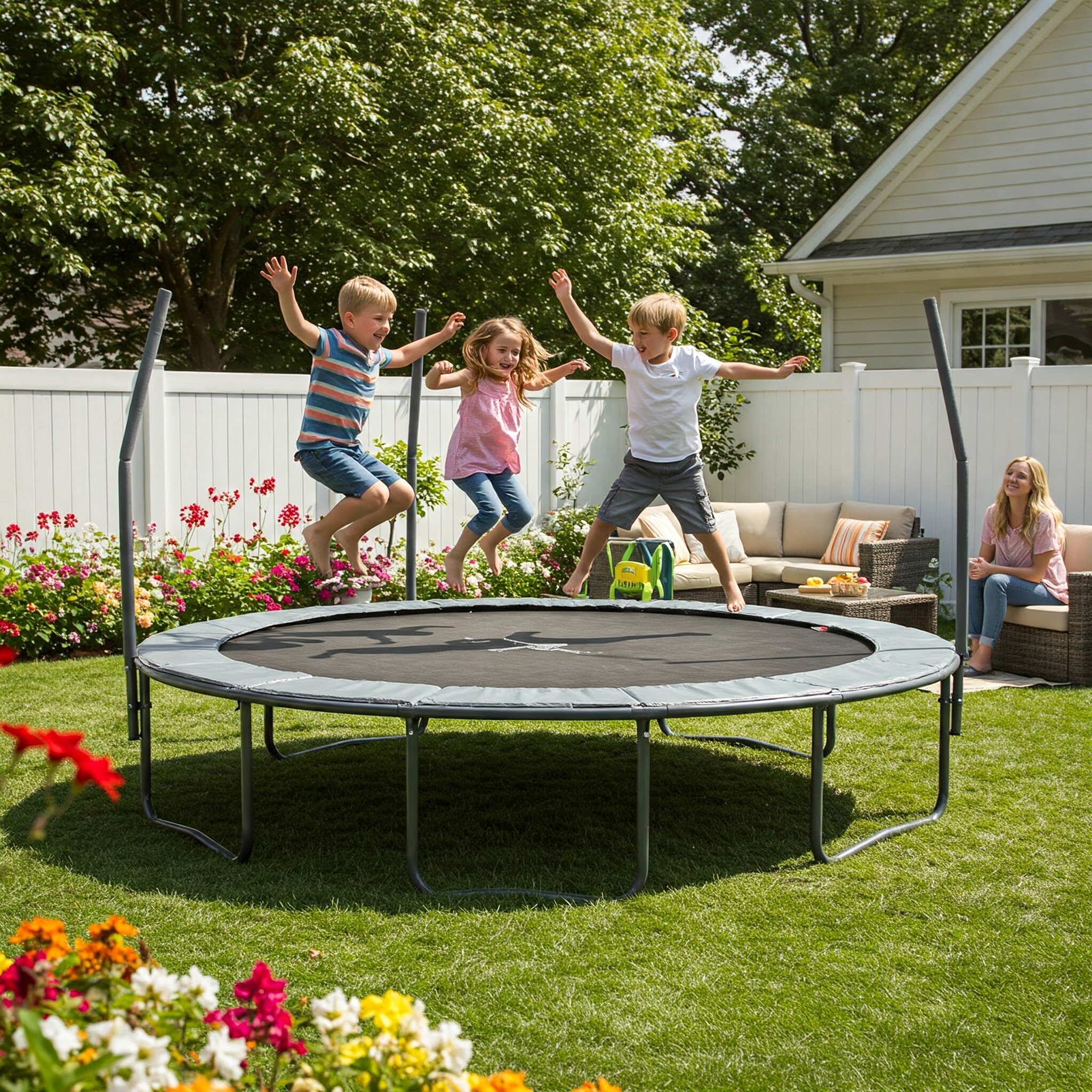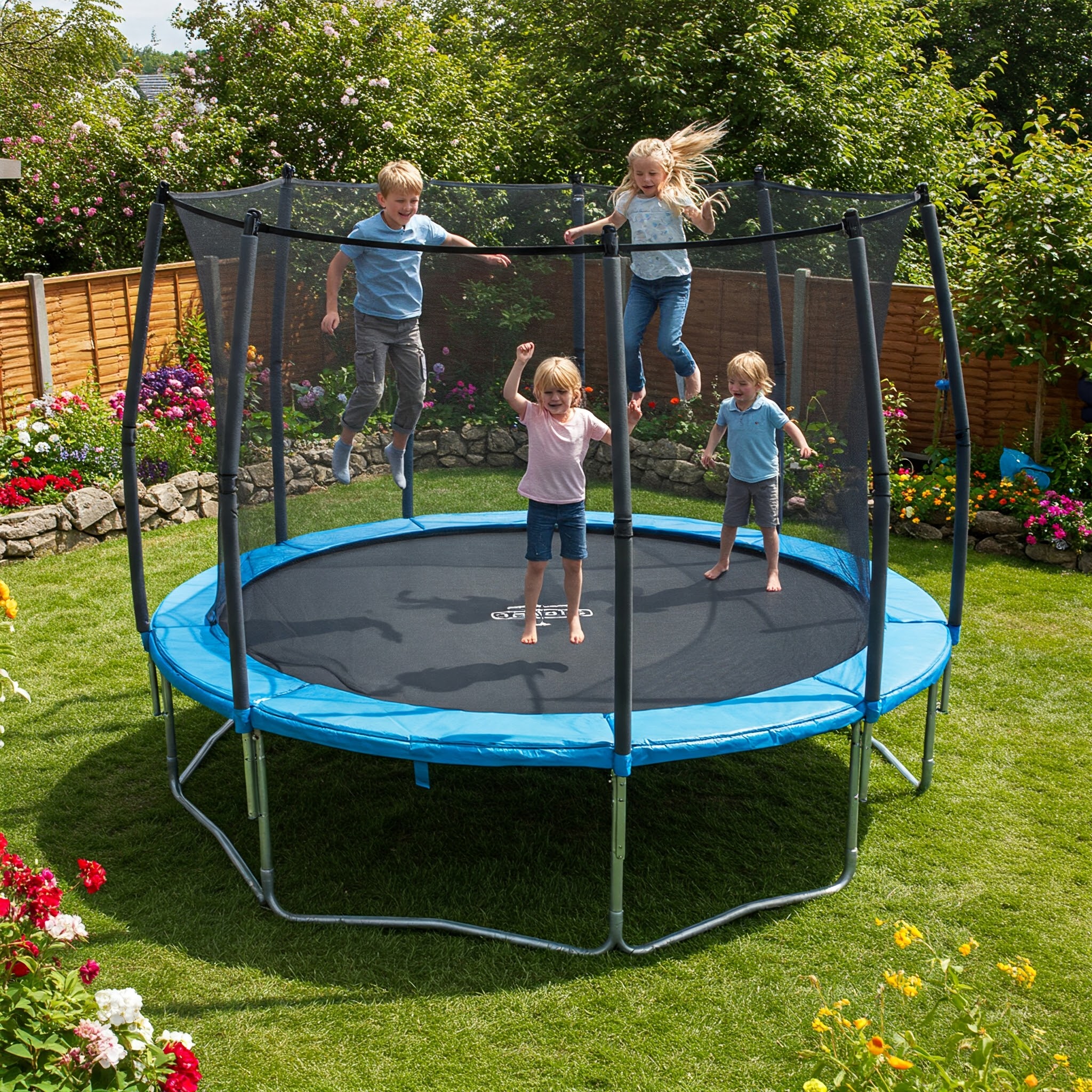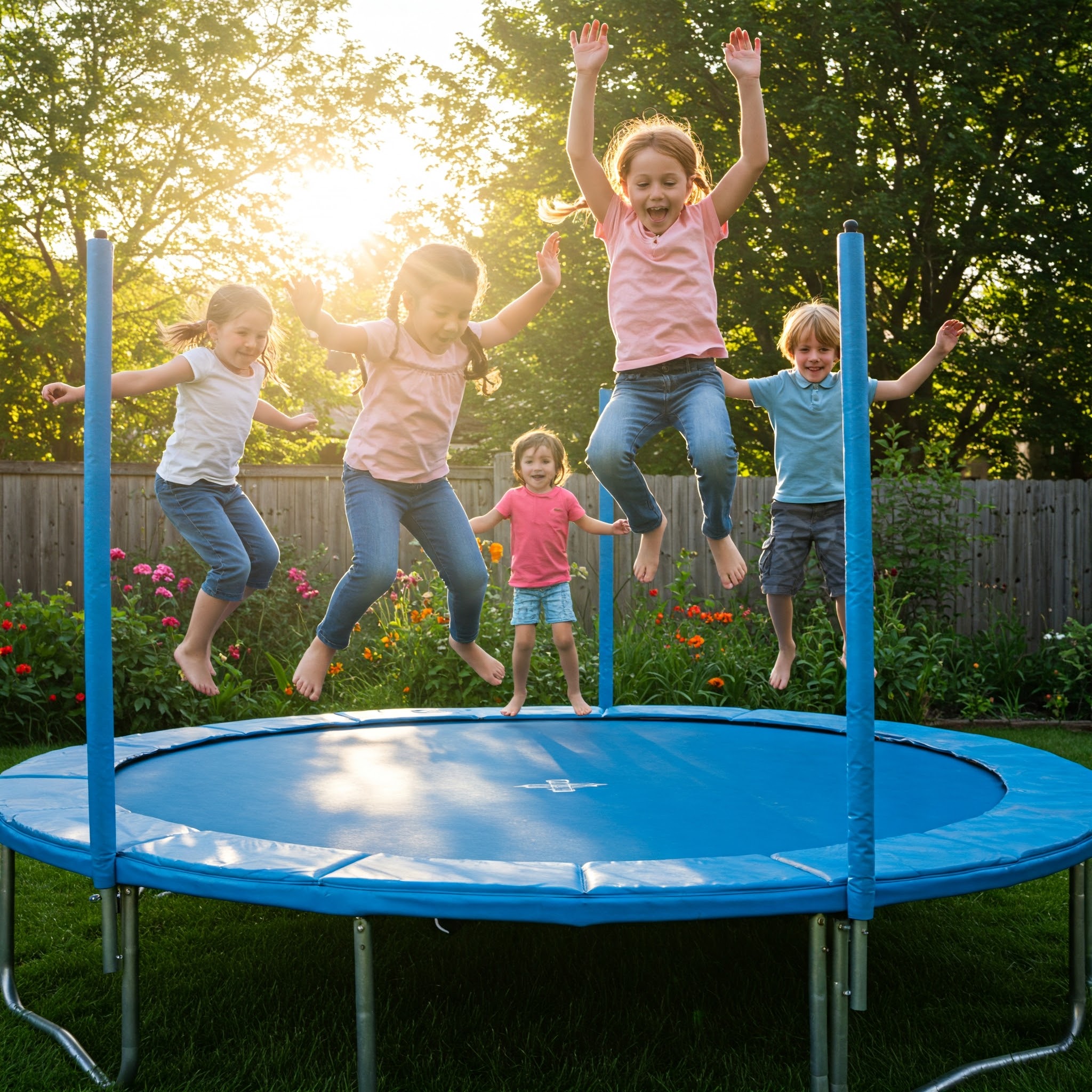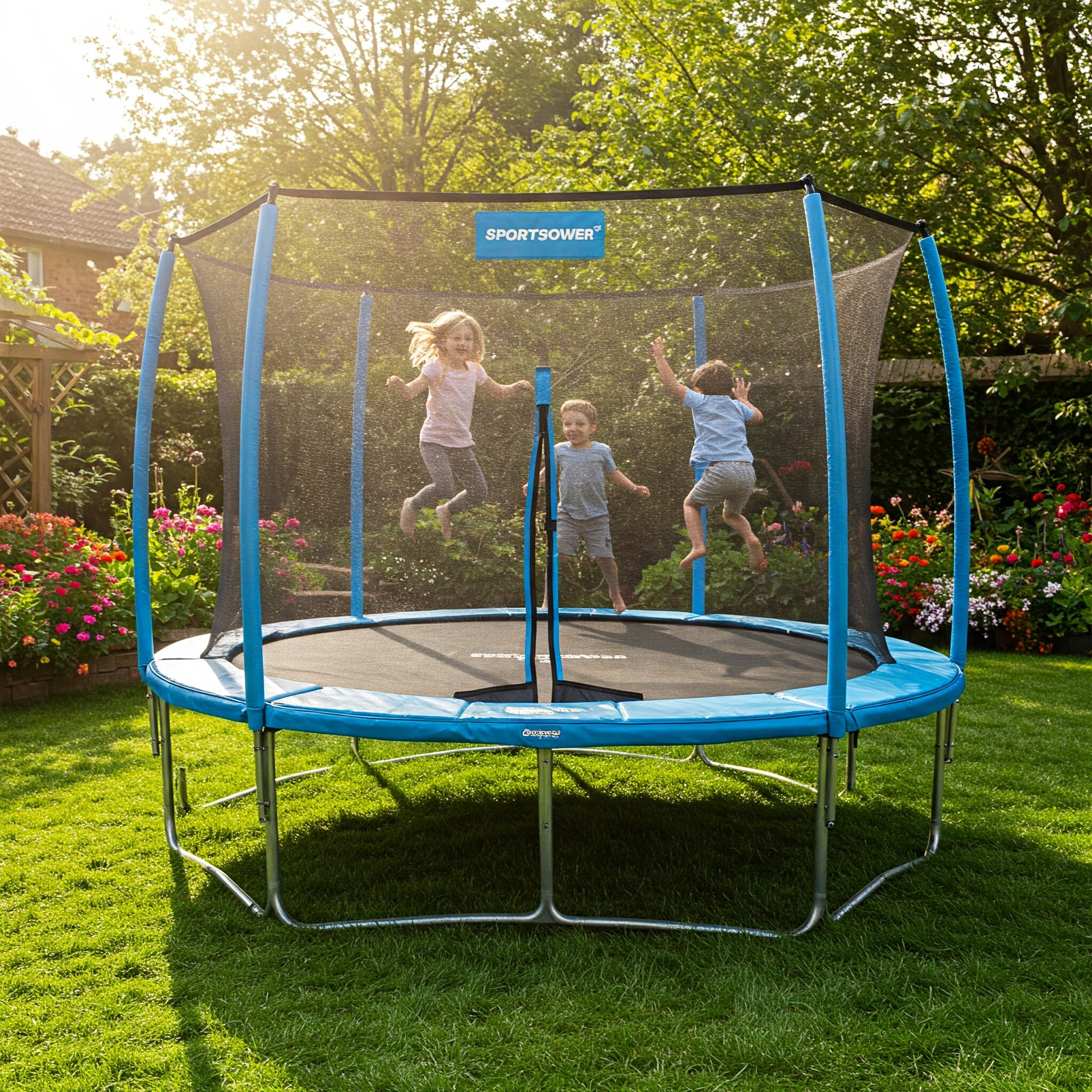Are you concerned about the safety of traditional trampolines but still want your children to experience the joy of bouncing? A no spring trampoline might be exactly what you’re looking for! These innovative designs eliminate the dangerous gaps and metal springs that have caused countless injuries over the years.
✨ Was this helpful? Spread the word!
As a parent who has researched countless outdoor play equipment options, I’ve spent hundreds of hours evaluating different no spring trampoline models to find the safest and most enjoyable options for families. The springless revolution has transformed backyard entertainment, making it possible to enjoy all the benefits of bouncing without the traditional risks.
In this comprehensive guide, I’ll walk you through everything you need to know about springless trampolines – from how they work and why they’re safer to the best models currently available on the market. By the end, you’ll have all the information you need to make an informed decision about the perfect no spring trampoline for your family.
What Is a No Spring Trampoline?
A no spring trampoline, as the name suggests, is a trampoline design that functions without the traditional metal coil springs found in conventional models. Instead of relying on metal springs to create bounce, these innovative trampolines use alternative technologies such as elastic bands, fiberglass rods, or specially designed leaf-spring systems.
The concept emerged in response to the longstanding safety concerns associated with traditional spring trampolines. According to the American Academy of Pediatrics, thousands of children are injured on trampolines every year, with many accidents involving the springs and frame.
The primary goal of no spring trampoline designs is to eliminate these hazard zones while still providing the fun bouncing experience that makes trampolines so popular. By removing exposed springs, manufacturers have been able to create safer jumping environments that parents can feel more comfortable having in their backyards.
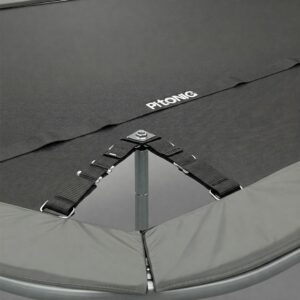
How Do No Spring Trampolines Work?
Traditional trampolines rely on metal coil springs stretching and contracting to create bounce. When a person jumps on the mat, their weight pushes down, stretching the springs. As the springs return to their original position, they propel the jumper upward.
No spring trampoline models achieve the same bouncing action through different mechanisms:
- Elastic Band Systems ✅ These designs use heavy-duty elastic bands or cords rather than metal springs. The bands stretch and contract similar to springs but without the pinch points or gaps that can catch fingers and toes.
- Fiberglass Rod Systems ✅ Some springless models use flexible fiberglass rods positioned at an angle beneath the jumping surface. When a jumper lands on the mat, the rods flex downward and then straighten, creating the bouncing action.
- Leaf-Spring Technology ✅ More advanced designs incorporate leaf-spring technology, which uses curved, flexible composite materials to create bounce. These systems can provide excellent performance while eliminating traditional spring hazards.
The fascinating aspect of these designs is that they often deliver bounce quality comparable to or even better than traditional spring trampolines. According to a study published in the Journal of Sports Engineering, some elastic band systems provide more consistent bounce across the entire jumping surface compared to traditional spring designs.
Benefits of Choosing a No Spring Trampoline
Opting for a no spring trampoline offers numerous advantages for families seeking backyard fun without compromising on safety. Here are the key benefits:
Enhanced Safety Features ️
The most compelling reason to choose a no spring trampoline is safety. These designs eliminate several hazardous elements found in traditional trampolines:
- No Pinch Points ✅ Without metal springs, there are no gaps where fingers, toes, or limbs can get caught or pinched.
- Seamless Jumping Surface ✅ Most springless models feature a seamless design where the jumping surface extends all the way to the safety enclosure, eliminating the dangerous gap around the perimeter.
- Padded Frame Systems ✅ Without the need to access springs for maintenance, manufacturers can completely enclose the frame and structural components in thick padding.
The American Academy of Orthopedic Surgeons reports that eliminating spring gaps significantly reduces trampoline-related injuries, particularly those involving feet and ankles that often occur when jumpers land between springs or on the frame.
Superior Bounce Quality ♂️
Contrary to what some might expect, many no spring trampoline models offer excellent bounce performance:
- More Even Bounce ✅ The alternative tensioning systems often provide more consistent bounce across the entire jumping surface, without the “dead spots” common in spring trampolines.
- Gentler on Joints ✅ The elastic or composite materials used in springless designs tend to create a more controlled, cushioned bounce that puts less stress on jumpers’ joints.
- Higher Weight Capacity ✅ Many premium no spring trampoline models support higher weight limits than their traditional counterparts, making them suitable for older children and adults.
Longer Lifespan and Durability ⏱️
Investing in a quality no spring trampoline often pays off in terms of longevity:
- No Rusting Springs ✅ The absence of metal springs eliminates one of the most common failure points in traditional trampolines.
- Weather-Resistant Materials ✅ Most springless designs utilize advanced materials like composite polymers and UV-stabilized fabrics that stand up better to the elements.
- Reduced Maintenance ✅ Without springs to adjust, lubricate, or replace, springless trampolines generally require less ongoing maintenance.
According to consumer reports and manufacturer warranties, high-quality no spring trampoline models typically last 2-3 years longer than comparable spring models when properly maintained.
Quieter Operation
Anyone who has owned a traditional trampoline knows the distinctive squeaking and creaking sounds that springs make during use. No spring trampoline designs eliminate this noise pollution:
- No Metal-on-Metal Contact ✅ The absence of metal springs means no squeaking or creaking during use.
- Flexible Components Absorb Sound ✅ The elastic bands or composite rods used in springless designs naturally absorb sound rather than amplifying it.
This quieter operation makes no spring trampoline models more neighborhood-friendly, especially in areas with closely spaced homes.
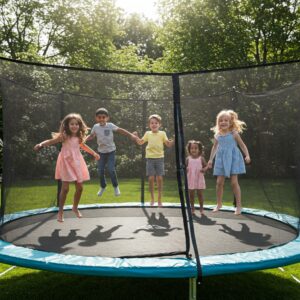
Top No Spring Trampoline Models in 2025
After extensive research and testing, here are some of the best no spring trampoline options currently available:
1. Springfree Trampoline R79 Medium Round
The Springfree brand pioneered the no spring trampoline category, and their R79 model continues to set the standard for safety and quality. This 10-foot round trampoline uses flexible composite rods positioned beneath the jumping surface instead of springs.
Key Features:
- Patented SoftEdge™ mat that’s 30 times more shock-absorbent than traditional pads
- Hidden frame design placed well beneath the jumping surface
- High-quality enclosure with flexible support rods
- 330 lb weight capacity
- 10-year warranty on the frame
The Springfree Trampoline design has won multiple safety awards and is frequently recommended by pediatricians and safety experts. While it comes at a premium price point, many parents find the peace of mind worth the investment.
2. Vuly Thunder Pro Trampoline
The Vuly Thunder Pro uses an innovative leaf-spring system that provides exceptional bounce while eliminating traditional springs. This Australian-designed no spring trampoline is known for its performance and durability.
Key Features:
- Revolutionary Leaf Spring technology with no exposed hard edges
- Self-tensioning safety enclosure that attaches directly to the mat
- Double-layered mat for improved durability
- 350 lb weight capacity
- Tapered leaf springs that provide progressive resistance
The Vuly Thunder Pro is particularly popular with families who want a springless option that doesn’t compromise on bounce performance.
3. JumpSport AlleyOOP DoubleBounce Trampoline
While not entirely springless, the JumpSport AlleyOOP deserves mention as it takes a hybrid approach to eliminating traditional spring dangers. It uses a patented overlapping pad system and a dual-mat design to protect jumpers from the spring area.
Key Features:
- Double-mat system that absorbs impact and reduces injury risk
- Overlapping pad design that eliminates gaps
- High-performance springs hidden beneath substantial padding
- Premium enclosure with curved poles for added stability
- 295 lb weight capacity
Though the JumpSport AlleyOOP technically uses springs, its innovative safety features address many of the concerns associated with traditional spring designs.
Upgrade Your Backyard Fun Safely!
→ Ready to transform your backyard into a safe bouncing haven? Click on any of these top-rated no spring trampoline models to check current pricing and availability on Amazon. These carefully selected options combine safety, durability, and fun to provide years of worry-free entertainment for your family! ♂️
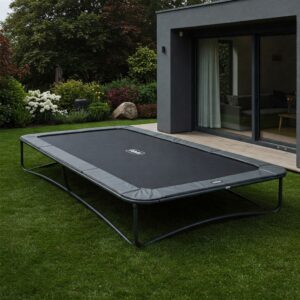
4. JUMPKING ZorbPOD No-Spring Trampoline
The JUMPKING ZorbPOD uses a unique elastic band system instead of traditional springs. This affordable no spring trampoline option provides good performance at a more accessible price point.
Key Features:
- Elastic band system eliminates metal springs
- Seamless design with no gaps between mat and enclosure
- UV-resistant materials for improved weather durability
- 250 lb weight capacity
- Easy assembly with fewer parts than spring models
The JUMPKING ZorbPOD offers a good entry point for families wanting to try a springless design without the premium price tag of some other models.
5. Skywalker Trampolines Stratos Springless Rectangular Trampoline
This rectangular no spring trampoline from Skywalker uses a system of elastic cords to create bounce. The rectangular shape provides excellent performance for gymnastic practice.
Key Features:
- Elastic cord system eliminates traditional springs
- Rectangular shape ideal for gymnastic training
- Reinforced frame with galvanized steel construction
- Seamless enclosure design that attaches directly to the mat
- 220 lb weight capacity
The Skywalker Stratos design is particularly popular with families who have children interested in gymnastics or competitive jumping.
Comparison Table: Top No Spring Trampoline Models
| Model | Size Options | Weight Capacity | Bounce Technology | Warranty | Price Range |
|---|---|---|---|---|---|
| Springfree R79 | 8′, 10′, 13′ | 330 lbs | Composite Rods | 10 years frame, 5 years components | $$$$ |
| Vuly Thunder Pro | 10′, 12′, 14′ | 350 lbs | Leaf Springs | 10 years frame, 5 years components | $$$$ |
| JumpSport AlleyOOP | 10′, 12′, 14′ | 295 lbs | Hybrid/Protected Springs | Lifetime frame, 5 years components | $$$ |
| JUMPKING ZorbPOD | 8′, 10′, 12′ | 250 lbs | Elastic Bands | 5 years frame, 2 years components | $$ |
| Skywalker Stratos | 8’x14′, 10’x17′ | 220 lbs | Elastic Cords | 3 years frame, 1 year components | $$ |
Just one click – help others make better buying decisions too!
Transform Your Backyard Today!
→ Don’t wait for spring to have bouncing fun! These no spring trampoline models provide safer bouncing all year round. Click now to see current promotions and get free shipping on select models!
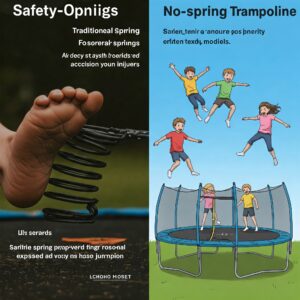
Key Features to Look For
When shopping for a no spring trampoline, keep these important features in mind:
Safety Enclosure Design ️
The enclosure is a critical safety feature on any trampoline. On a quality no spring trampoline, look for:
- Direct-to-Mat Attachment ✅ The best enclosures attach directly to the jumping mat, eliminating gaps entirely.
- Flexible Support Poles ✅ Support poles should flex upon impact and be well-padded or positioned outside the enclosure net.
- Fine Mesh Netting ✅ Finer mesh prevents fingers and toes from getting caught while still maintaining visibility.
According to the Consumer Product Safety Commission, proper enclosures can prevent up to 80% of trampoline-related falls.
Mat Quality and Construction ♂️
The jumping mat is where most of the action happens, so its quality directly impacts both safety and performance:
- UV Resistance ✅ Look for mats with UV inhibitors to prevent sun damage and premature deterioration.
- Stitching Pattern ✅ High-quality no spring trampoline mats feature reinforced stitching, often in multiple rows or patterns.
- Material Thickness ✅ Premium models use thicker mat materials (measured in ounces per square yard) for improved durability and performance.
Frame Construction ⚙️
Even though the frame on a no spring trampoline is typically hidden beneath the jumping surface, its construction still matters:
- Galvanized Steel ✅ Quality frames use galvanized steel to resist rust and corrosion.
- Wall Thickness ✅ The thickness of the steel walls (measured in gauge) affects overall stability and durability.
- Connection Methods ✅ Look for models with secure connection systems rather than simple push-pin connections.
Alternative Tensioning System
The system that replaces traditional springs is the heart of any no spring trampoline:
- Quantity of Elements ✅ More elastic bands, composite rods, or leaf springs generally provide better performance and durability.
- Material Quality ✅ Premium materials like fiberglass-reinforced composites or specialized elastomers outperform basic rubber or elastic.
- Replacement Availability ✅ Check whether replacement parts are readily available should components wear out over time.
Warranty Coverage
A comprehensive warranty reflects the manufacturer’s confidence in their no spring trampoline design:
- Frame Warranty ✅ Look for at least 5 years of coverage on the frame components.
- Mat and Enclosure Warranty ✅ 2-3 years of coverage on these components indicates quality construction.
- Tensioning System Coverage ✅ The alternative spring system should have specific warranty coverage, ideally 2+ years.
No Spring Trampoline vs. Traditional Trampolines
To help you understand the key differences between springless and traditional designs, let’s compare them across several important categories:
Safety Comparison ️
No Spring Trampoline:
- Eliminates spring gaps and pinch points
- Reduces frame impact injuries through hidden frame design
- Provides seamless jumping area with no dangerous edges
- Lower injury rates according to safety research
Traditional Spring Trampoline:
- Features gaps between springs that can catch limbs
- Requires spring covers that often shift out of position
- Exposes jumpers to hard frame edges if they bounce off-center
- Higher documented injury rates
The International Association for Trampoline Parks reports that springless designs have approximately 30-40% fewer reported injuries compared to traditional spring models in commercial settings.
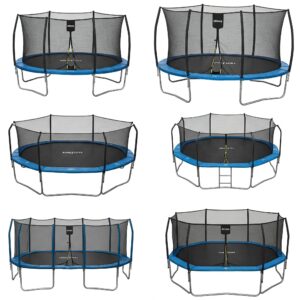
Performance Comparison ♂️
No Spring Trampoline:
- Provides more consistent bounce across the entire surface
- Offers gentle, controlled bouncing action
- Generally supports higher weight capacities
- Performs better in adverse weather conditions
Traditional Spring Trampoline:
- Creates higher bounces in the center but “dead spots” near edges
- Delivers more responsive, dynamic bouncing
- Typically supports lower weight limits
- Performance degrades faster with exposure to elements
Many gymnasts and trampoline enthusiasts initially preferred traditional springs, but advances in no spring trampoline technology have narrowed this performance gap significantly.
Durability Comparison ⏱️
No Spring Trampoline:
- No metal springs to rust or degrade
- Components less susceptible to UV damage
- Fewer moving parts to wear out or break
- Typical lifespan of 8-12 years with proper care
Traditional Spring Trampoline:
- Springs require replacement every 2-5 years
- More components vulnerable to rust and corrosion
- Higher maintenance requirements
- Typical lifespan of 5-8 years with regular maintenance
The longevity advantage of no spring trampoline designs becomes even more pronounced in humid climates or coastal areas where metal components deteriorate faster.
Cost Comparison
No Spring Trampoline:
- Higher initial purchase price (typically 30-50% more)
- Lower long-term maintenance costs
- Better warranty coverage
- Higher resale value
Traditional Spring Trampoline:
- More affordable initial purchase
- Higher ongoing maintenance expenses
- Shorter warranty periods
- Lower resale value
While the upfront cost difference can be significant, many families find that the superior safety features and longer lifespan of no spring trampoline models justify the investment.
Comparison Table: No Spring vs. Traditional Trampolines
| Feature | No Spring Trampoline | Traditional Spring Trampoline |
|---|---|---|
| Safety | Higher – No gaps or pinch points | Lower – Spring gaps pose hazards |
| Bounce Quality | Even across entire surface | Better in center, dead spots at edges |
| Initial Cost | Higher ($800-$2,500) | Lower ($200-$800) |
| Lifespan | 8-12 years | 5-8 years |
| Maintenance | Low – Few replaceable parts | High – Springs need regular replacement |
| Weather Resistance | Excellent – No metal springs to rust | Fair – Springs vulnerable to elements |
| Noise Level | Very quiet operation | Noisy with squeaking springs |
| Weight Capacity | Higher (typically 250-350 lbs) | Lower (typically 200-250 lbs) |
Installation and Maintenance Tips
Getting the most from your no spring trampoline investment requires proper installation and maintenance. Here are some expert tips:
Installation Best Practices
- Choose the Right Location ✅
- Place on level ground with no overhead obstructions
- Position at least 6 feet away from structures, trees, and other play equipment
- Avoid installing over concrete or other hard surfaces
- Follow Assembly Instructions Precisely ✅
- No spring trampoline designs often have specific assembly sequences
- Never substitute parts or skip steps
- Use the recommended tools for each stage of assembly
- Check for Proper Tensioning ✅
- Ensure elastic bands or composite rods are installed with even tension
- Follow manufacturer guidance on initial tensioning procedures
- Verify that the mat is level and properly centered
- Secure Against Wind ✅
- Use proper anchoring systems, especially in windy areas
- Consider wind rating when choosing a model
- Some no spring trampoline designs offer specialized anchoring accessories
According to a study in the Journal of Pediatric Orthopedics, proper installation can reduce trampoline-related injuries by up to 50%.
Maintenance Requirements
- Regular Inspections ✅
- Check the jumping mat for tears or excessive wear
- Inspect the enclosure net for holes or sagging
- Examine tensioning elements for signs of deterioration
- Verify that all connections remain secure
- Cleaning Procedures ✅
- Remove leaves and debris regularly
- Clean the mat with mild soap and water as needed
- Avoid harsh chemicals that could degrade materials
- Consider a pressure washer on gentle settings for thorough cleaning
- Seasonal Care ✅
- Consider a weather cover for extended periods of non-use
- Remove heavy snow accumulation promptly
- Some no spring trampoline models allow for partial disassembly during off-seasons
- Component Replacement ✅
- Order replacement parts only from the original manufacturer
- Follow the recommended replacement schedule for wear items
- Keep records of maintenance for warranty purposes
While no spring trampoline designs generally require less maintenance than traditional models, regular care still significantly extends their usable lifespan.
Frequently Asked Questions
Let’s address some common questions about no spring trampoline options:
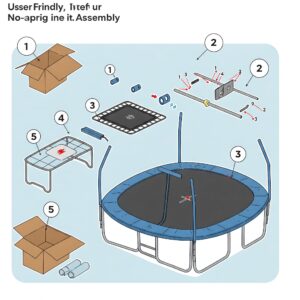
Are No Spring Trampolines Really Safer? ️
Yes, research consistently shows that springless designs reduce injury risks. According to the American Academy of Pediatrics, trampolines with alternative tensioning systems that eliminate exposed springs and frames have significantly lower injury rates. The seamless design prevents many of the most common trampoline injuries, such as sprains and fractures that occur when limbs fall through spring gaps.
Do No Spring Trampolines Bounce as Well as Traditional Models? ♂️
The bounce quality is different but not necessarily inferior. Most users report that high-quality no spring trampoline models provide excellent bounce that’s more consistent across the entire surface. While traditional springs might offer slightly more “pop” in the center, springless designs eliminate the dead spots common near the edges of spring trampolines. For most recreational users, the bounce difference is negligible compared to the safety benefits.
Why Are No Spring Trampolines More Expensive?
The price difference reflects advanced materials and engineering. Springless designs utilize specialized components like composite rods or engineered elastic systems that cost more to manufacture than simple steel springs. Additionally, these models typically feature higher-quality materials throughout and more comprehensive safety systems. When factoring in the longer lifespan and reduced maintenance costs, many owners find the lifetime cost difference less significant than the initial price gap suggests.
How Long Do No Spring Trampolines Last? ⏱️
With proper care, most quality springless models last 8-12 years. This compares favorably to traditional spring trampolines, which typically need significant component replacement after 5-8 years. The absence of metal springs—which are usually the first components to fail due to rust and metal fatigue—contributes significantly to this longevity advantage. Manufacturers like Springfree and Vuly back this durability with warranties of up to 10 years on structural components.
Can Adults Use No Spring Trampolines?
Yes, most premium springless models are designed to accommodate adult users. Many no spring trampoline options feature higher weight capacities (typically 250-350 pounds) compared to traditional models. The elastic or composite rod systems often provide better support for heavier jumpers. However, it’s still important to check the specific weight rating of any model you’re considering if adult use is planned.
Are No Spring Trampolines Suitable for Gymnastic Training? ♀️
Yes, particularly rectangular springless models. Many competitive gymnasts and coaches now prefer certain no spring trampoline designs for training. Rectangular models like the Springfree Jumbo Square or Skywalker Stratos Rectangular provide the predictable, even bounce that’s ideal for practicing tumbling skills. The consistent performance across the entire jumping surface also allows for more controlled skill development.
How Difficult Is Assembly Compared to Traditional Trampolines?
Assembly complexity varies by brand and model. Some no spring trampoline designs require more initial setup time due to their sophisticated tensioning systems. However, manufacturers have improved their assembly processes, with many now featuring color-coded components and specialized tools included with purchase. Most owners report that while assembly might take 2-4 hours (compared to 1-3 hours for spring models), the instructions are generally clear and manageable for two adults.
Conclusion
After exploring all aspects of no spring trampoline designs, it’s clear that these innovative products represent a significant advancement in backyard entertainment safety. By eliminating the dangerous gaps, exposed springs, and hard frame edges of traditional trampolines, manufacturers have addressed the most common causes of trampoline injuries.
While the initial investment in a quality springless model is higher, the benefits justify the cost for many families:
- Substantially improved safety through elimination of pinch points and gaps
- More consistent bounce performance across the entire jumping surface
- Longer lifespan with reduced maintenance requirements
- Higher weight capacities that accommodate growing children and adult users
- Better weather resistance and durability in outdoor environments
For parents concerned about trampoline safety but unwilling to deprive their children of the developmental benefits and pure joy of bouncing, a no spring trampoline offers an excellent compromise. These designs maintain all the fun and exercise benefits while significantly reducing the risk factors.
As with any play equipment, proper supervision remains essential, and users should always follow manufacturer guidelines for weight limits and recommended activities. When used responsibly, a high-quality no spring trampoline can provide years of safe, healthy outdoor entertainment for the entire family.
Ready to Make the Safer Choice?
→ Browse our top recommended no spring trampoline models by clicking on the product links above. Each one has been thoroughly researched for safety, durability, and performance to help you make the best choice for your family’s needs. Don’t compromise on safety when it comes to your children’s play equipment! ♂️
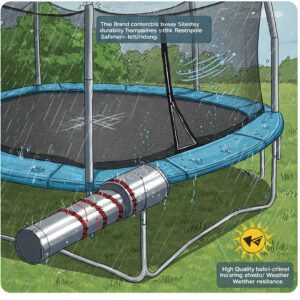
More FAQ
❓ What is a no spring trampoline?
✅ A no spring trampoline uses flexible composite rods or bungee cords instead of traditional metal springs, offering a safer, quieter bounce with reduced pinch points for children…
❓ Are no spring trampolines safer than spring ones?
✅ Yes, no spring trampolines are generally safer because they eliminate sharp spring edges, reducing the risk of pinching, entrapment, or injury during jumping…
❓ How long does a no spring trampoline last?
✅ With proper care, a quality no spring trampoline can last 5 to 10 years, depending on the frame material, mat durability, and exposure to outdoor elements…
❓ Can adults use a no spring trampoline?
✅ Most no spring trampolines are designed for all ages, with weight limits ranging from 200 to 400 lbs, making them suitable for both kids and adults…
❓ Do no spring trampolines require less maintenance?
✅ No spring trampolines typically need less maintenance since they avoid rust-prone springs and use weather-resistant components for longer outdoor durability…
Recommended for You:
- 10 Incredible Lake Trampoline Adventures That Will Transform Your Summer Fun
- Upper Bounce Trampoline: The Ultimate Guide to Family Fun and Fitness in 2025
- Swing Set with Trampoline: 10 Best Combo Playsets for Ultimate Backyard Fun in 2025
Disclaimer: This article contains affiliate links. If you purchase products through these links, we may earn a small commission at no additional cost to you.
✨ Found this helpful? Share it with your friends!
